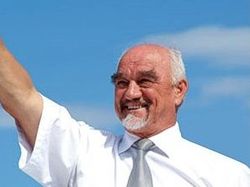
TRANSNISTRIA’S “GOVERNMENT” SHOWCASES FOREIGN, MINORITY RULE
Publication: Eurasia Daily Monitor Volume: 4 Issue: 24
By:

On January 31 Transnistria “president” Igor Smirnov finished forming the new “government,” which is a reshuffled version of the preceding one. The new government enjoys, at least on paper, more powers than its predecessor, as part of attempts to institutionalize the de facto authorities in the “Transnistria Moldovan Republic” (TMR, the official name). This government’s most salient new feature is the complete exclusion of even token Moldovans from among its members, along with retention of the key figures sent in from Russia.
The TMR has all along claimed that it constitutes a titular “Moldovan” entity and continues insisting on that point, at the same time portraying itself as a “multinational republic” in the Soviet tradition. Moldovans form the largest ethnic group — a plurality of the total population and an absolute majority of the native-born population — while Ukrainians are second and Russians third in numerical order. However, power is concentrated in Russian hands; and within this category, non-native Russians hold sway over the locally born Russians and Russified Ukrainians.
The last identifiable ethnic Moldovan in the TMR “government” — “minister” for ecology and natural resources Iurie Ceban — has disappeared from the reshuffled composition. The TMR Supreme Soviet no longer has a token Moldovan chairman (the Smirnov loyalist Grigory Marakutsa lost that post in a reshuffle last year). Thus, the authorities in Tiraspol and Moscow no longer deem it necessary to maintain the pretense of TMR being anything else than, basically, a Russian project.
Smirnov himself hails from Khabarovsk in eastern Siberia; he arrived in Tiraspol as a factory director in 1986 and became in 1990 “president” of the Moscow-created TMR. The “foreign affairs minister,” Valery Litskay, is originally from Tver oblast in Russia. The “defense minister,” General Stanislav Hazheyev, was a Soviet and then Russian army officer, originally from Chelyabinsk. The national security minister, MVD General Vladimir Antyufeyev — widely seen as the most powerful figure in the TMR leadership — is a former OMON officer in Riga, wanted for crimes committed in Latvia and Lithuania, and who moved via Russia to Tiraspol.
Smirnov’s son Vladimir, head of customs, holds the most lucrative post in this government. All the other “ministers” have Russian or Ukrainian surnames. Ethnic Ukrainian officials in the TMR, particularly at the senior level, are as a rule not nationally conscious; apart from few exceptions they tend to be linguistically Russified and politically Russo-centric, with Supreme Soviet chairman Yevgeny Shevchuk an illustration of this phenomenon.
Although the Transnistria conflict does not stem from ethnic or “national” problems and has not affected social relations among ethnic groups to this day, the conflict does have serious political implications on that level. The TMR continues in slightly updated form the old Soviet “nationality policies” of cultural and linguistic Russification, in this case of Moldovans and Ukrainians. The TMR’s officially declared goal is to forge a new type of identity — the “multinational people of Transnistria” — basically akin to the concept of the “multinational Soviet people” in former Soviet republics. The Soviet-era ethnic tokenism is disappearing in the TMR, however.
This vision implies a homogenized collectivity characterized by the use of Russian as lingua franca and, increasingly, for private communication as well, recognition of Russians as the ruling element in a supranational political construction, and a Moscow-centered world outlook. That experiment ultimately failed across the former Soviet Union; but it continues and advances in Transnistria through the TMR’s educational, language-use, and media policies, as an aspect of Russia’s geopolitical project in the wider region.
Thus, building on Soviet-era foundations with major inputs from Russia, the TMR constitutes a unique combination of minority rule and foreign rule — necessarily backed by police rule and military force — in contemporary Europe. The reappointment of the core ruling team in TMR’s latest government reshuffle underscores this reality. By the same token it underscores that negotiating with Tiraspol’s existing authorities toward any power sharing in Moldova is pointless and dangerous.
Moscow and the Tiraspol authorities never actually pushed for the full and final secession of Transnistria from Moldova. On the contrary, they have time and again sought to devise power-sharing arrangements whereby Tiraspol would obtain a strong influence on the central Moldovan government, in a Russia-arbitrated constitutional setup. With this option in mind, the TMR retains the pro-forma designation “Moldovan” in its title. Such a settlement would pull Moldova back into Russia’s orbit. This strategy is realistic as long as right-bank Moldova and Ukraine remain institutionally weak.
During the final days of January, the Shevchuk-chaired Supreme Soviet passed resolutions revoking its own earlier decisions to approve the creation of a “federation” or “confederation” with the rest of Moldova. The resolutions just passed are declarative, as were the earlier decisions to approve a settlement based on “federalism.” Such declarations and revocations can be re-revoked at will. Russian-brokered “federalism” under this or another name remains the basis for Moscow’s and Tiraspol’s conflict-settlement proposals.
(Olvia Press, Infotag, Interfax, September 29, 2006-February 1, 2007; see EDM, February 1)




